Daisy Stingray
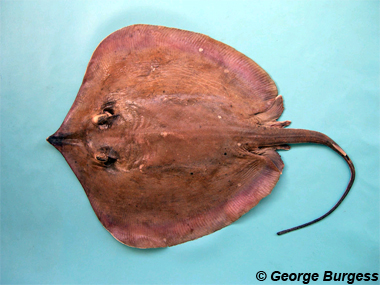
Dasyatis margarita
This smaller, oval-shaped stingray has a pointed snout, and a round, pearl-like tubercular thorn in the very top center of the stingray’s disc. Its tail is slightly longer than its body, thick at the base and whip-like at the end, with one long, serrated venomous spine about a third of the way down. The stingray can get as wide as 40 inches, but usually is only around 24, and it is gray brown on the top and nearly white underneath.
Order: Myliobatiformes
Family: Dasyatidae
Genus: Dasyatis
Species: margarita
Common Names
English language common names of this ray include daisy stingray, Guinean stingray, stingray, skeete, and whipray. Other common names are adadu (Ewe), gblinggbling (Adioukrou), koungbe (Aizi), margrietpijlstaartrog (Dutch), ogoncza perelkowa (Polish), ozouin (Fon GBE), pastenague marguerite (French), pisica de mare perlata (Rumanian), raie (French), raja látigo margarita (Spanish), ratón de altura (Spanish), raya látigo margarita (Spanish), stechrochen (German), tatra (Ewe), uge-de-pérola (Portuguese), and uje-margarida (Portuguese).
Importance to Humans
Of some interest to commercial fisheries, the daisy stingray is caught with bottom trawls, trammel nets, bottom set longlines, and hook-and-line. It is sometimes utilized in Nigeria to treat severe skin infections as part of their natural healing practices.
Danger to Humans
The daisy stingray is considered harmless to humans. However, the serrated tail spines can inflict severe or potentially fatal wounds so care should be taken if this species is handled.
Conservation
> Check the status of the daisy stingray at the IUCN website.
The IUCN is a global union of states, governmental agencies, and non-governmental organizations in a partnership that assesses the conservation status of species.
Geographical Distribution
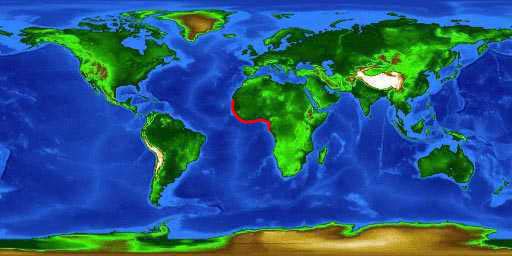
This stingray resides in the eastern Atlantic Ocean from Mauritania to Angola along the western coast of Africa.
Habitat
Common in marine and estuarine habitats within its range, the daisy stingray is demersal, residing at depths to 197 feet (60 m). As common among stingrays, swimming is achieved through the undulation of the pectoral fins.
Biology
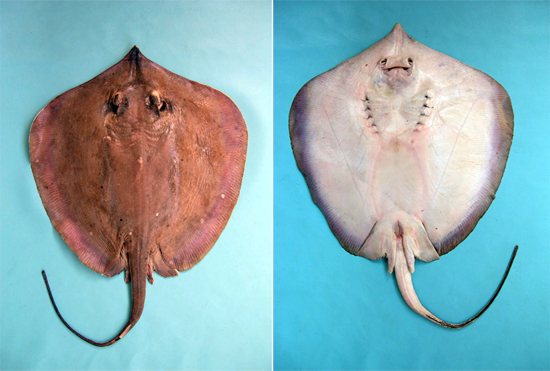
Distinctive Features
The disc of the daisy stingray is oval and moderately flat in shape. The medial lobe is broad-based and the anterolateral margin is somewhat concave. The snout of this ray is long and broadly pointed. The daisy stingray has a serrated stinging spine grows from the whip-like tail. On the ventral side of the spine, there are two grooves which contain venom-secreting glandular tissue. The spine itself is covered in a thin layer of skin referred to as the integumentary sheath in which the venom is concentrated. This anatomical feature is what gives stingrays their common name. The daisy stingray is often confused with D. margaritella, the pearl stingray which also resides in the same region.
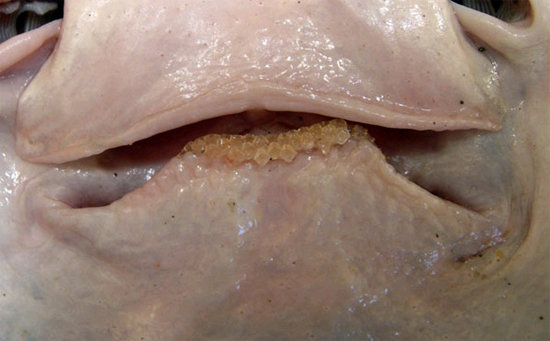
Coloration
The disc and pelvic fins of the daisy stingray are gray-brown above, without spots or prominent markings. It uniformly pale or whitish along the ventral surface.
Dentition
Stingrays have multiple rows of rounded teeth that have flat, blunt surfaces. The teeth of the upper jaw are largest midway along the jaw line and decrease towards the outer corners. The lower jaw has teeth of uniform size throughout. There are 24-32 teeth in the upper jaw and 28-36 teeth in the lower jaw of the daisy stingray.
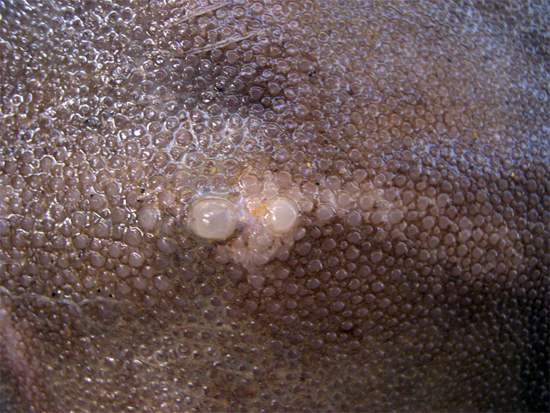
Denticles
Dermal denticles, characteristic of elasmobranchs, are less developed in Myliobatiformes. An area of close-set spinules are located along the dorsal surface of the disc. These spinules are smooth and restricted to the middle portion of the daisy stingray. A large, pearl-like tubercular thorn is also present; it is located just anterior to the spinules.
Size, Age, and Growth
The maximum reported size of the daisy ray is 39.4 inches (100 cm) disc width; the maximum reported weight of this species is 37.5 pounds (17.0 kg). Average spine length in mature males is 1.6 inches (40 mm) with approximately 52 serrations, while mature females have spines measuring 1.8 inches (45 mm) in length and 64 serrations.
Food Habits
Daisy stingrays feed on marine invertebrates including shrimps, crabs, bivalves, and annelids. In one study off the coast of Sierra Leone and Guinea, stomach contents of daisy stingrays included the crustacean Sicyonia galeata and cephalopods of the genus Rossia.
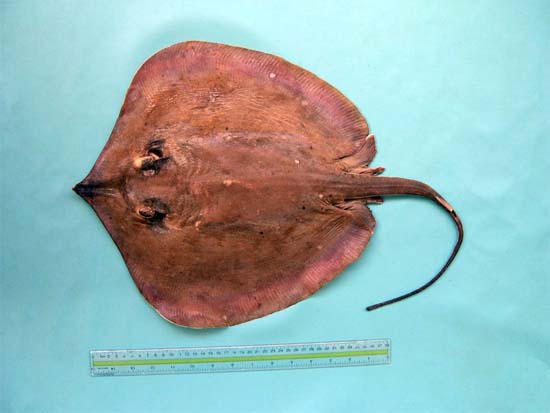
Reproduction
Florida populations exhibit an annual protracted mating season beginning in October or November and ending in April. However, The reproductive mode of this stingray is ovoviparity (aplacental viviparity). Embryos initially feed on yolk, then receive additional nourishment from the mother stingray through the indirect absorption of uterine fluid. This uterine fluid is enriched with mucus, fat, and protein through specialized structures.
Predators
Great hammerheads (Sphyrna mokarran) have been documented as feeding on daisy stingrays. Potential predators of the daisy stingray are larger fish including sharks.
Taxonomy
The daisy stingray was originally named Trygon margarita by Günther, 1870. Albert Günther, a German-born British zoologist, is renown for his work in ichthyology. He published the Catalogue of the Fishes of the British Museum between 1859 and 1870. The scientific name of this species was later changed to Dasybatus margarita and Dasyatis margarita, the latter of which is the currently valid scientific name. The genus Dasyatis of the currently accepted scientific name is derived from the Greek word “dasys” meaning rough or dense and (“b)atus” meaning shark.
Prepared by: Cathleen Bester